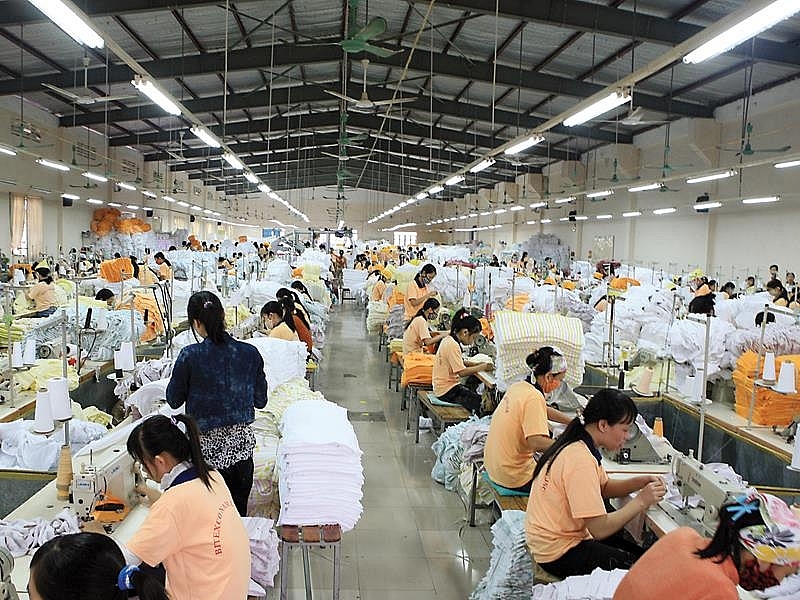Technology application—a new trend in HR training ahead of CPTPP
 |
| Vietnam needs to address the growing demand for skilled workforce |
For years, a shortfall of skilled workforce has remained a thorny issue for both domestic and FIEs in Vietnam. As shown in the Provincial Competitiveness Index (PCI) 2017, only 31 per cent of nearly 1,800 FIEs are satisfied with the labour quality in Vietnam.
The Vietnamese workforce over the age of 15 is 53.5 million strong, but only 9.99 million people or 18.6 per cent are skilled workers, meaning unskilled workers make up 81.4 per cent of the country’s total workforce.
The local workforce also lacks many necessary skills, like problem solving, IT, especially foreign language skills, and adaptability. Moreover, the levels of innovation and creativity among skilled local employees are still low.
Looking at the competitiveness of businesses in Vietnam, it is easy to see how low quality workforce bridles the GDP growth rate. Every year, Vietnam's labour productivity increases by 3 per cent on average, while GDP expands at around 5 per cent.
According to the General Statistics Office, Vietnam's labour productivity is even lower than Laos and Cambodia, and just one tenth of Singapore. In 2017, Vietnam's labour productivity was estimated at VND93.2 million ($4,159) per labourer. This figure is equal to 7 per cent of Singapore and 17.6 per cent of Malaysia. Singapore and Malaysia are also two member countries of the CPTPP.
As enterprises continue to expand business and investment activities in the country, demand for qualified manpower grows more significantly than ever. However, improving labour quality in a cost-saving and effective manner is a big concern.
At present, each Vietnamese firm spends around VND400,000 ($18.18) each year training an employee on average.
Meanwhile, Angeline Teo, director of dOz International (Singapore), said that businesses that are thought to be successful in human resources development must spend 8 per cent of their revenues on such purposes.
Vietnam is home to more than 500,000 enterprises, but over 90 per cent do not have their own internal training management system.
| E-learning would be an optimal choice for businesses to improve their human resources quality and save on training costs. |
According to experts, e-learning would be an optimal choice for businesses to improve their human resources quality and save on training costs.
In developed countries, businesses focus on the application of high-tech solutions in training. The Industry 4.0 has resulted in the rapid development of e-learning, while cloud computing technology helps save costs and proves more efficient than traditional training methods.
In Vietnam, technology solutions for e-training remain in the early stages of development with only a handful of suppliers.
One of the famous brands is Huong Viet Group, which has ten years of experience in technology solutions for education and training with CLS.vn (Cloud Learning System)—the modules for training management based on a cloud system.
CLS-Cloud Learning System (cls.vn) has proved to be a reasonable solution for smaller businesses as it is very cost-effective and easy to use.
 |
| The interface of a Cloud Learning System-based training management system |
It is estimated that with CLS businesses can reduce 75 per cent of training costs and save 95 per cent of training time and 100 per cent of housing and travelling costs for trainers and trainees, thus helping businesses increase operational efficiency by 2.5 times and triple labour productivity.
With a cheap cost (less than 10 per cent of foreign-developed technology solutions), CLS brings in an advanced internal training system for domestic and foreign-invested enterprises, with standards equal to those of developed markets. CLS is predicted to become the driving force of the e-learning market in Vietnam.
| In globalisation and global integration, improving the quality of workforce is the key to increase competitiveness. |
"In globalisation and global integration, improving the quality of workforce is the key to increase competitiveness," said Tran Van Ba, deputy director of Huong Viet Group.
Currently, CLS is being applied at 500 businesses throughout the country, ranging from distribution, retail, and services to education.
In the technology era, Vietnamese firms can only stand firm if they pay due attention to applying technology in human resources training. If they fail to make changes, they might fall behind or be gobbled up, leaving the playground for FIEs to benefit from the CPTPP.
According to a new World Bank report, the CPTPP will bring direct economic benefits to Vietnam. The CPTPP, along with other multilateral trade agreements, is expected to further boost investment in Vietnam through its export-driven growth model.
The World Bank estimated that the CPTPP would lead to an increase of 1.1 per cent in Vietnam’s GDP by 2030, which could rise to 3.5 per cent given a modest boost to productivity.
All income groups in Vietnam are expected to benefit from this new trade deal, and highly-skilled workers may reap the most benefits.
 | ManpowerGroup optimistic about the future of work in Vietnam Vietnam’s demand for highly-skilled workers has been growing steadily, buoyed by increasing foreign investment inflow. |
 | Human resources management: core mindset of a billion-dollar enterprise By investing $300 million to build three new plants in 2013, Tan Hiep Phat Group now has a daily capacity of three million litres of ... |
 | Vietnam faces severe shortage of IT manpower Vietnam is facing a severe shortage of information technology (IT) workers though there is a large number of universities and colleges teaching IT nationwide, heard ... |
 | Human resources training needs improvement The so-called fourth industrial revolution, also known as Industry 4.0, will provide more development opportunities for businesses but will also require businesses to prepare qualified ... |
What the stars mean:
★ Poor ★ ★ Promising ★★★ Good ★★★★ Very good ★★★★★ Exceptional
Themes: CPTPP
Related Contents
Latest News
More News
- Takeda supports health resilience amid climate change challenges (December 18, 2025 | 12:39)
- Mondelez Kinh Do - a chapter of purpose-led leadership in Vietnam (December 18, 2025 | 09:44)
- VNPAY services receive the highest-level PCI DSS international security certificates for six consecutive years (December 17, 2025 | 23:47)
- PPL extends its reach into ASEAN (December 17, 2025 | 15:44)
- Over 600 BUV graduates meeting quality benchmarks across triple quality assurance levels (December 17, 2025 | 13:00)
- HEINEKEN Vietnam partners with Ho Chi Minh City Traffic Police on road safety drive (December 17, 2025 | 09:42)
- BUV and China’s CSCSE sign MoU to boost educational cooperation (December 17, 2025 | 08:00)
- PVT Logistics honoured with ‘Fast Enterprise Award’ at APEA 2025 (December 16, 2025 | 18:22)
- Empowering Sustainable Data Centers with Smart Infrastructure Solutions (December 16, 2025 | 13:59)
- Vietjet wins gold ESG transport sustainability award in Taiwan (China) (December 13, 2025 | 22:03)

 Tag:
Tag:


























 Mobile Version
Mobile Version